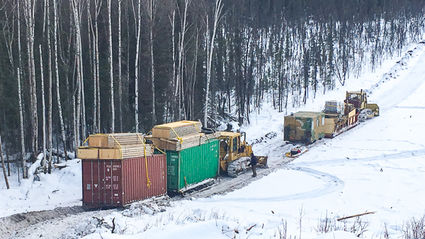Australia explorer gets early Alaska start
North of 60 Mining News – May 11, 2018
Last updated 9/25/2020 at 4:51am

White Rock Minerals Ltd.
Transporting supplies over a winter trail positioned White Rock for an early start to exploration at Red Mountain.
White Rock Minerals Ltd. May 10 said crews have begun mobilizing to its Red Mountain property in preparation for an early start to exploration at this zinc rich volcanogenic massive sulfide project about 50 miles west of Delta Junction in Interior Alaska.
"A lot of preparation has gone into the planning for the commencement of field activities as early as possible in the 2018 field season. It is great to see all the hard work coming together as field crews begin to mobilize with first drilling expected to be underway within two weeks," said White Rock CEO Matt Gill.
Last year, Australia-based White Rock commissioned a resource calculation for the two main deposits at Red Mountain – Dry Creek and West Tundra Flats – that meets modern reporting standards.
This maiden Australian Joint Ore Reserves Committee- (JORC)compliant calculation found that Dry Creek and West Tundra Flats host 16.7 million metric tons of inferred resource averaging 4.1 percent (1.49 billion pounds) zinc; 1.7 percent (630 million lb) lead; 0.2 percent (57.3 million lb) copper; 99 grams per metric ton (53.5 million ounces) silver; and 0.7 g/t (352,000 oz) gold.
West Tundra Flats, the highest grade of the two VMS deposits, hosts 6.7 million metric tons of this resource averaging 6.2 percent zinc, 2.8 percent lead, 189 g/t silver, 0.1 percent copper and 1.1 g/t gold.
Significant results from historical drilling at West Tundra Flats include: 1.3 meters grading 21 percent zinc, 796 g/t silver, 9.2 percent lead, 10.2 g/t gold and 0.6 percent copper; 3 meters grading 7.3 percent zinc, 796 g/t silver, 4.3 percent lead, 1.1 g/t gold and 0.2 percent copper; and 1.7 meters grading 11.4 percent zinc, 372 g/t silver, 6 percent lead, 1.7 g/t gold and 0.2 percent copper.
Dry Creek, situated about 2,750 meters southeast of WTF, hosts the balance of the metals defined so far at Red Mountain.
Significant results from historical drilling at Dry Creek include: 4.6 meters grading 23.5 percent zinc, 531 g/t silver, 8.5 percent lead, 1.5 g/t gold and 1 percent copper; 5.5 meters grading 25.9 percent zinc, 346 g/t silver, 11.7 percent lead, 2.5 g/t gold and 0.9 percent copper; and 7.1 meters grading 15.1 percent zinc, 334 g/t silver, 6.8 percent lead, 0.9 g/t gold and 0.3 percent copper.
Upgrading and expanding these zinc-rich VMS deposits will be the focus of an initial 3,000 meters of drilling slated to begin later this month.
While the drills are turning, crews will be carrying out ground electromagnetic geophysical surveys and possibly geochemistry exploration across the Dry Creek and West Tundra Flats. By comparing the results with what is known about the mineralization of these two known deposits, this orientation exercise will help determine the best geophysics and geochemistry exploration tools to use to prioritize the 30 earlier staged prospects across the Red Mountain property.
White Rock plans to prioritize these targets with further sampling and geophysics and drill the highest priority targets towards the end of the season.
It is expected that the geophysics crew (Zonge International) will commence their on-ground work in mid-June.
"There is a real sense of anticipation that the on-ground geochemistry and geophysics teams, combined with drill testing, could yield additional high-grade zinc deposits that catapult the project to the next stage and realize White Rock's aspiration to develop a new mine," said Gill.
–SHANE LASLEY



Reader Comments(0)